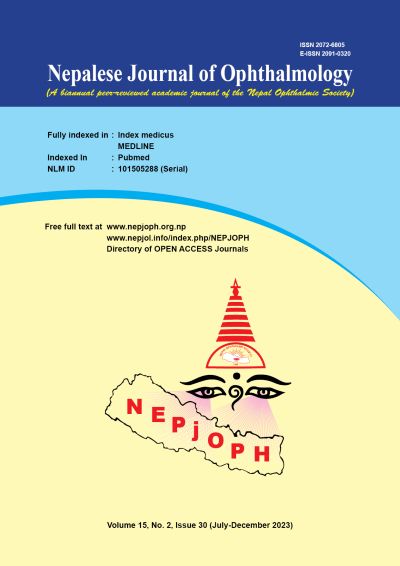Role of Psychological Stress and Choroidal Thickness in Central Serous Chorioretinopathy
DOI:
https://doi.org/10.3126/nepjoph.v15i2.53598Keywords:
Aetiology, central serous chorioretinopathy, choroid, optical coherence tomography, psychological stressAbstract
Introduction: Central serous chorioretinopathy (CSCR) is a disease with a multifactorial aetiology.
Objectives: To evaluate the role of psychological stress and choroidal thickness in patients with CSCR.
Materials and methods: This was a hospital-based, analytical cross-sectional study, conducted at Christian Medical College, Vellore, India, from 2018 February to 2019 September, after the approval of the Institutional Review Board and Ethics Committee. Patients who satisfied the eligibility criteria of the study, were selected from the outpatient clinics of the Department of Ophthalmology. Twenty-five patients with unilateral CSCR (Group 1 - cases), and 50 age and gender-matched patients without CSCR (Group 2 - controls), randomly selected in a 1:2 ratio, were enrolled after obtaining informed consent. Psychological stress was assessed using Cohen Perceived Stress Scale (PSS-10). All patients had a Swept Source optical coherence tomography scan of the macula. Subfoveal choroidal thickness (SFCT) of both eyes of all participants was measured using a standard protocol. The data were collated and analysed, using Independent samples t-test and Chi-square/ Fisher’s exact test, as appropriate, with IBM SPSS Statistics for Windows, version 21 (IBM Corp., Armonk, N.Y., USA).
Results: There was a significant difference between the two groups in mean stress scores (p <0.01), as well as stress categories (p <0.01). Although there was no significant difference in the prevalence of hypertension between the two groups (p = 0.33), there was a significant difference both in the mean systolic (p <0.01) and diastolic (p <0.01) blood pressure between the two groups. We found a significant difference between mean SFCT of CSCR eyes (421+/- 78.34 μm) and control eyes (314.24 +/- 52.48 μm, p <0.01), as well as between fellow eyes (396.20 +/- 68.79 μm) and control eyes (314.24 +/- 52.48 μm, p <0.01). However, there was no significant difference in the mean SFCT of CSCR eyes and fellow eyes (p =0.24).
Conclusion: The findings reiterate the concept that the underlying pathophysiological changes leading to CSCR involve both the eyes of the patient. Psychological stress and hypertension may be factors that play an important role in the etiopathogenesis of the pachychoroid-related changes leading to CSCR. Stress relief measures, with a holistic approach to management, should be an integral part of the therapeutic strategies for CSCR.
Downloads
Downloads
Published
How to Cite
Issue
Section
License
Copyright (c) 2023 Nepalese Journal of Ophthalmology

This work is licensed under a Creative Commons Attribution-NonCommercial-NoDerivatives 4.0 International License.
This license enables reusers to copy and distribute the material in any medium or format in unadapted form only, for noncommercial purposes only, and only so long as attribution is given to the creator.




